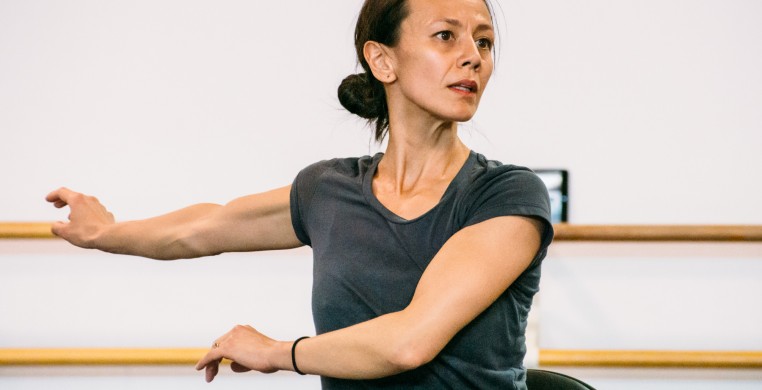The fifth year of The Bridge Dance Festival showcased Asian American and Pacific Islander (AAPI) dancers from Chicago at Links Hall over the weekend of November 17-18. The festival featured three experimental performances by dancers Chih-Jou Cheng, Chih-Hsien Lin, Momoko Ishikuro, and Robyn Mineko Williams. Under the curation of creative producer Yoshinojo Fujima, each dancer unveiled choreography delving into themes of “Asian Identity” and the perceived stereotypes that come with it.
The three-part show began with a collaborative piece created and performed by Chih-Jou Cheng and Chih-Hsien Lin titled “Unfinished Island Songs.” The piece aims to explore their ever-changing relationship with Taiwan in a bittersweet ode to the country's complicated transformation of land and history.
The opening scene sets a solemn tone as the auditorium resonates with the ominous sounds of a train, while a spotlight mimicking a train's headlights focuses intensively on the dancers. The pair of dancers, with bells attached to their ankles, slowly shuffles in sync towards the light, emitting with each step an eerie sound reminiscent of chains. A solitary bamboo pole resting between their shoulders, adds a physical weight that forces the dancer to stoop low with their gaze fixed downward.
As the sounds of the train fade away into a gentle background of natural ambiance, the bamboo pole, a symbol of endurance as well as flexibility within Taiwanese culture, transitions from being an oppressive force into a source of connectivity between the dancers. No longer forced upon their shoulders, the bamboo is used to twirl and fling the dancers in a whirlwind of unbridled joy. Gazing upward, hopping with delight, the air resounds with their uplifting shouts of glee and the soft jingle of bells.
As the performance reaches its conclusion, one dancer falls back into a slow shuffle, the bamboo pole once again resting on their shoulders, while the other begins to don modern clothes, looking upward towards a brighter future. Distressed by the regression of their partner and the weight they still carry, the newly dressed dancer seeks to alleviate the burden by adorning the bamboo with clothes and enveloping their partner in a gentle blanket. Despite this attempt to help their companion, their efforts prove futile as the pole continues to bear down on the slouching dancer and forces the dancers to part ways.
 Photo by Maho Kurita
Photo by Maho Kurita
The second piece, choreographed and presented by Momoko Ishikuro, "The Moon Is Beautiful" draws inspiration from the phrase coined by Japanese writer Natsume Soseki as an alternate expression of “I love you.” This performance delves into the complicated dynamics of the Japanese sense of modesty and explores how it can hinder impulses and true desires.
The performance began with a lone spotlight bathing the stage, mimicking the soft glow of a full moon, with much of the performance unfolding within that confined circle. The music intensified this sense of enclosure, featuring the haunting vocal performance by Akaihirume. Her vocals extended every vowel and consonant to an almost uncomfortable duration which intensified the sense of dread and confinement within the audience.
Momoko's performance itself was truly ethereal, captivating the audience with her extraordinary flexibility and control. Drawing on her expertise in contortion, she executed full-body spirals and moved through varied levels of lunges. Managing to keep herself close to the ground with minimal bodily contact, she generated a beautiful sense of tension, leaving the audience on the edge of their seats, anticipating a fall that never came.
The concluding performance, choreographed and enacted by Robyn Mineko Williams, featured selected and adapted segments from her latest creation, "Hisako’s House". These excerpts explore her Japanese-American heritage, delving into her family's narrative of World War II incarceration and the intergenerational echoes of trauma, love, and resilience that followed.
The piece commenced with a projector casting photos of Robyn’s family onto a back corner wall accompanied by the sounds of an interview with her grandmother. As the screen transitions through vintage stills and the narration fills the auditorium, Robyn situates herself in the opposite corner, creating a distance between herself, the projector, and the audience. There, she becomes absorbed in an improvisational stretch, executing deep lunges, elongated back stretches, and slow arches of her feet, forcing the audience to choose where to direct their focus.
As the projector and interview gradually fade, Robyn moves to the center and begins to interact with the projector cloth. Wrapping her body around it and pulling the material to the ground, she tangles herself within her past, reaching and submerging herself in her ancestral history. The dance unfolds with sharp twists of the spine, slow arms swiping and embracing the body, and concluding with a slow waltz, danced with an imaginary partner; as if dancing with the echoes of her past.
The Bridge Dance Festival’s Fifth Annual Season concluded a resounding success, with each performance sparking meaningful dialogue around the nuanced experience of AAPI individuals and artists. The impactful works by Chih-Jou Cheng, Chih-Hsien Lin, Momoko Ishikuro, and Robyn Mineko Williams will linger in memory, solidifying The Bridge Dance Festival as a must-attend event for the coming years.

